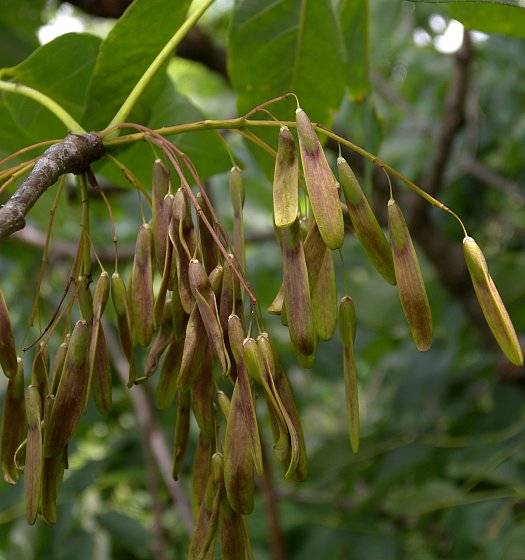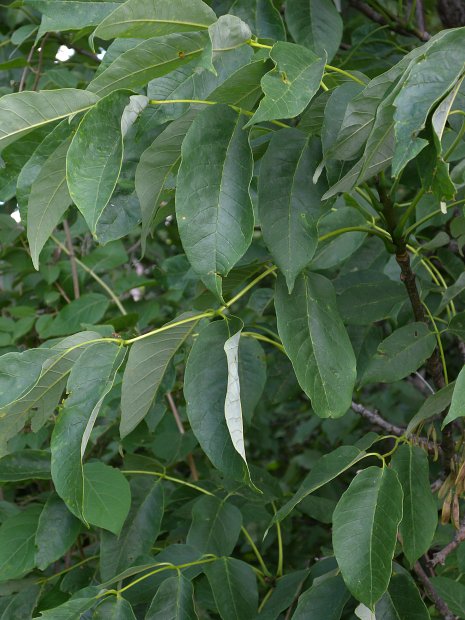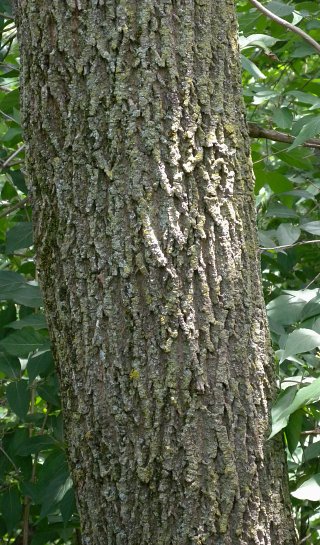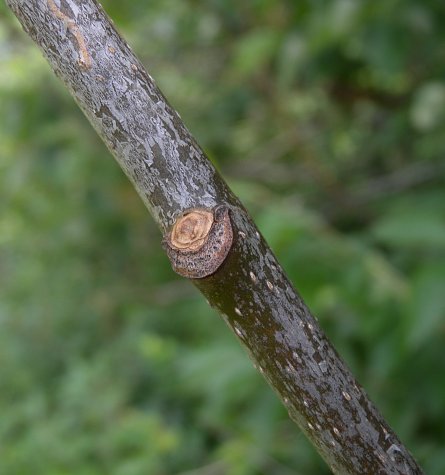White Ash
Fraxinus americana
Olive family (Oleaceae)
Description: This tree is 50-100' tall at maturity, forming a long stout trunk and a variable crown: in open areas, the crown is ovoid, in forested areas the crown is more narrow and slightly pyramidal. The trunk bark is light to dark gray and deeply furrowed, forming interweaving diamond-shaped patterns; the thick ridges are flat-topped. Bark of branches and twigs are gray to grayish brown and smooth; young twigs often have a whitish bloom. Lichens are often abundant on the bark of the trunk and larger branches. Young shoots are green, terete, and usually hairless. Pairs of opposite compound leaves develop along these shoots. Individual leaves are 8-15" long and odd-pinnate with 5-9 leaflets (usually there are 7 leaflets). The petiole and rachis of each compound leaf are light green and usually hairless. The petiole scars on the twigs are shaped like the letter 'U' or a narrow crescent moon.

Individual leaflets are 2½-5" long and about one-half as much across; they are elliptic, lanceolate-ovate, or ovate with margins that are smooth to slightly serrated. Each leaflet has a short petiolule (basal stalklet). The upper leaflet surface is medium green and hairless, while the lower surface is pale green to whitish green and usually hairless. Trees with pubescent shoots, petioles, rachises, and leaflet lower sides can be referred to as Fraxinus americana biltmoreana (Biltmore Ash), while the more common typical variety is hairless. The flowers bloom during the spring before the leaves develop. Because White Ash is dioecious, individual trees have either all male (staminate) flowers or all female (pistillate) flowers. Male flowers occur in tight clusters along 2nd-year twigs. Individual male flowers are less than 1/8" (3 mm.) across, consisting of a tiny tubular calyx and 2 stamens. They vary in color from yellowish green to greenish purple. Female flowers occur in small panicles on 2nd-year twigs. They are less than 1/8" (3 mm.) across, consisting of a tiny tubular calyx and a pistil with a single style. Neither male flowers nor female flowers have corollas. The flowers are cross-pollinated by the wind.

Afterwards, male flowers soon wither away, while fertile female flowers are transformed into one-seeded samaras, which hang from drooping panicles. Individual samaras are about 1½" long, consisting of a seed body and elongated membranous wing. The seed body is more round in cross-section than flattened, while the narrow membranous wing does not extend much beyond the lateral margins of the seed body. Immature samaras are green to reddish green, while mature samaras are light to dark brown. They usually remain on the tree into the fall or winter before being distributed by the wind. The woody root system is moderately deep and spreads widely; it usually has both a taproot and major lateral roots. The deciduous leaves become reddish purple or yellow during the fall."
Cultivation: White Ash prefers partial to full sun, moist to dry-mesic conditions, and a deep loamy soil that is high in nitrogen and calcium. Small saplings can tolerate more shade than mature trees. This tree is vulnerable to the disease complex, Ash Yellows, which is potentially fatal. It is also somewhat sensitive to ozone, sulfur dioxide, and other forms of air pollution.
air pollution.
Range & Habitat: The native White Ash is fairly common in most areas of Illinois, except the NW section of the state, where it is occasional (see Distribution Map). Habitats include floodplain woodlands (in better-drained areas), upland woodlands, edges of shaded gravelly seeps, high riverbanks, limestone glades, and city parks. This tree can be found in both disturbed wooded areas and old-growth deciduous forests. Sometimes White Ash is cultivated as a landscape tree.
Faunal Associations: White Ash and other native ash trees (Fraxinus spp.) are host plants of many species of insects, which feed on the leaves, plant juices, wood, and other parts of these trees. Among these insect feeders are larvae of wood-boring beetles, leaf beetles, larvae of weevils, larvae of gall flies, plant bugs (especially Tropidosteptes spp.), aphids, armored scales, treehoppers, mealybugs, larvae of sawflies, thrips, larvae of many moths, and larvae of a butterfly, the Tiger Swallowtail (Papilio glaucus). Another butterfly, the Harvester (Feniseca tarquinius), has carnivorous larvae that feed on the woolly aphids of ash trees. The Insect Table provides a more complete list of these insect feeders. The seeds of the samaras are a source of food for various birds, including the Wood Duck, Northern Cardinal, Evening Grosbeak, Purple Finch, Pine Grosbeak, Red-winged Blackbird, Rusty Blackbird, Bobwhite Quail, and Wild Turkey (Martin et al., 1951/1961; DeGraaf, 2002). Because of the large number of insects that ash trees attract, insectivorous birds often forage in ash trees. This includes such species as the Scarlet Tanager, Summer Tanager, Yellow-billed Cuckoo, Tufted Titmouse, Carolina Chickadee, Prothonotary Warbler, Northern Parula, Cerulean Warbler, Yellow-throated Warbler, Blue-gray Gnatcatcher, Acadian Flycatcher, Yellow-throated Vireo, and Red-eyed Vireo (Gabbe et al., 2002). Ash trees also provide nest sites and protective cover for many kinds of birds, including the Red-shouldered Hawk, Eastern Screech Owl, Common Grackle, and Red-bellied Woodpecker (Moorman & Chapman, 1996; Homan et al., 1996; Belthoff & Ritchison, 1990; Jackson, 1976). These trees are often used as roost sites for various bats, including Rafinesque's Big-eared Bat, Hoary Bat, Indiana Bat, Evening Bat, Northern Long-eared Bat, and Tricolored Bat (Krynak, 2010; Veilleux et al., 2003; Clement, 2011; Baerwald et al., 2012; Carter, 2003; MuÌnzer, 2008). The foliage and twigs of ash trees are browsed occasionally by the American Moose and White-tailed Deer; the North American Porcupine and American Beaver feed on the bark and/or wood. The seeds of the samaras are eaten by such mammals as the White-footed Mouse, Deer Mouse, Fox Squirrel, and Cottontail Rabbit (Hamilton, 1941; Martin et al., 1951/1961; Whitaker, 1966; personal observation).
Photographic Location: Along a riverbank near Busey Woods in Urbana, Illinois.

Comments: Because the wood of White Ash is strong, flexible, and shock-resistant, it is highly regarded and used in the construction of furniture, doors, cabinets, veneer, railroad ties, wood paneling on antique cars, boats, tool handles, baseball bats, archery bows, canoe paddles, snowshoes, polo sticks, tennis rackets, and other wooden items. White Ash can be distinguished from another common species, Fraxinus pennsylvanica (Green Ash or Red Ash) by the shape of its petiole scars on the twigs (like a narrow crescent moon or letter 'U'), the pale lower surface of its leaflets, and the structure of its samaras: the winged membrane of each samara does not extend much beyond the lateral margins of the seed body. In contrast, Fraxinus pennsylvanica (Green Ash or Red Ash) has petiole scars that are shaped like a half-circle or wide crescent moon, and the winged membrane of its samaras extends to at least the middle of the seed body's lateral margins. Other technical characters, such as the cross-sectional shape of the twigs and the presence or absence of petiolules, can be used to distinguish White Ash from other Fraxinus spp. (ashes) in Illinois.



 air pollution.
air pollution.